How could an alien spacecraft work?
The story of the film "Arrival" (without spoilers), told by the film's scientific adviser, Stephen Wolfram

Contact Hollywood
“An interesting scenario,” said one of our PR team [at Wolfram]. We have already got used to receive requests from film companies to show our graphics or posters or books in films. But this time it was different: we were asked if we could quickly create realistic things for a big Hollywood sci-fi film project, which is already going to start shooting?
In our company, unusual tasks usually end up in my inbox. It so happened that thanks to a combination of leisure and professional interest, I have seen almost all mainstream NF films in the past few decades. But on the basis of the working title “The Story of Your Life,” I could not even understand whether it would be an NF-film and what it would be about.
Then, having learned that the film was about the first contact with aliens, I said "of course, I will read the script." And, yes, the script was interesting. Difficult, but interesting. I was not very clear whether the film would be more about sf or about love. But there were indeed interesting references to science - albeit mixed with meaningless nonsense, and occasionally there were also scientific blunders.
')
Watching the NF-films, I often feel annoyed, thinking "someone spent $ 100 million on a film and made such terrible scientific mistakes that it would be so easy to fix, ask him the right person." So I decided that even though I was very busy, I needed to take part in what is now called "Arrival" and contribute as much as possible to the scientific approach.
I think there are several reasons why a proper scientific approach is not practiced in Hollywood films. First, filmmakers do not feel the scientific background of their pictures. At the household level, they may realize that something is wrong - but in the case of the scientific approach, their knowledge is not enough. Sometimes they call the local university and ask for help, but often they are sent to a highly specialized academic, whose whole help is that he tells them that their whole story is wrong. Of course, most often the pursuit of science does not greatly affect the success of the film. But it seems to me that such a follow up can help turn a good film into a great one.
Our company has experience with Hollywood, for example, we wrote all the math for the six seasons of the television series Numb3rs . Personally, I was not involved in the films before, but many of my friends worked in the cinema. Jack Horner worked on the “ Jurassic Park ”, as a result of which he stands behind virtually all paleontological theories, including those that turned out to be false. Kip Thorn (known for his recent triumph in detecting gravitational waves ) was the main force behind the Interstellar film. He also made the original effects for the black hole with the help of Mathematica. Before him, there was Marvin Minsky , who was a consultant on the film " Space Odyssey 2001 ", and Ed Fredkin , who became the model of the eccentric doctor Falken in War Games . There is also Manul Bhargava, a man who has cognized infinity for ten years, who has been carrying on the idea of the film “The Man Who Has Cognized Infinity ”.
All these people were involved in making films at a very early stage. But I decided that if I join the film before the very beginning of the shooting, I will have an advantage - I will know what the film is most likely to do. At the same time, my role was clear - I only needed to trim the science in the film. I did not even need to think about changing something serious in the plot.
The inspiration for the film was the 1998 story by Ted Chiang [ Ted Chiang ]. But the concept of the story was complex, taking the beginning from a rather technical idea from mathematical physics - and I was not the only one wondering how a film could be made on it. But here it is in front of me, a 120-page script containing a bit of science from the original story, and adding a lot of other things. And I got to work, commenting, giving advice, proposing corrections, etc.
A few weeks later
My son Christopher and I arrived at the film set in Montreal. In the large pavilion next door another film of the X-Men series is being shot. The “Arrival” pavilion is more modest. We arrive there at a time when the group shoots the scene in a helicopter. We do not see actors, but we watch what is happening on the monitor along with a couple of producers and other people.
The first thing I hear is “I prepared a list of questions [for aliens], starting with a few binary sequences ...”. And I think, “Wow, that’s what I suggested! Cool!". But then comes the new double. And the change of text. And more doubles. And yes, the dialogue sounds better. But the meaning is not the same. And I understand that it will be harder than I thought. Many compromises. Many difficulties. Fortunately, in the end, the film produced a good dialogue and the correct meaning.
After some time, a break in filming. We are talking to Amy Adams , a linguist who talks to aliens. For some time she went for a local professor of linguistics , and enthusiastically talks about how widely used language defines thinking - and I have been interested in this topic as a developer of computer languages for a long time. But the producers want me to talk to Jeremy Renner , who plays physics. He feels ill at ease, and we go with him to the “scientific tent” built for the shooting, and think over the good visual details.

Write the code
The script offers many possibilities for creating interesting scenes. But, despite the fact that I would be interested to create them, I did not have time for this. Fortunately, my son Christopher, a fast and creative programmer, had an interest in this. At first we thought to send him to work at the filming site, but since he was still very young, he began to work remotely.
The strategy chosen by him was simple: “if we really did it, what analysis and calculations would we do?”. We had a list of alien landing sites - what is their choice? We have the geometric shape of a spacecraft - what does it mean? We have a text "written" by aliens - what does it mean?
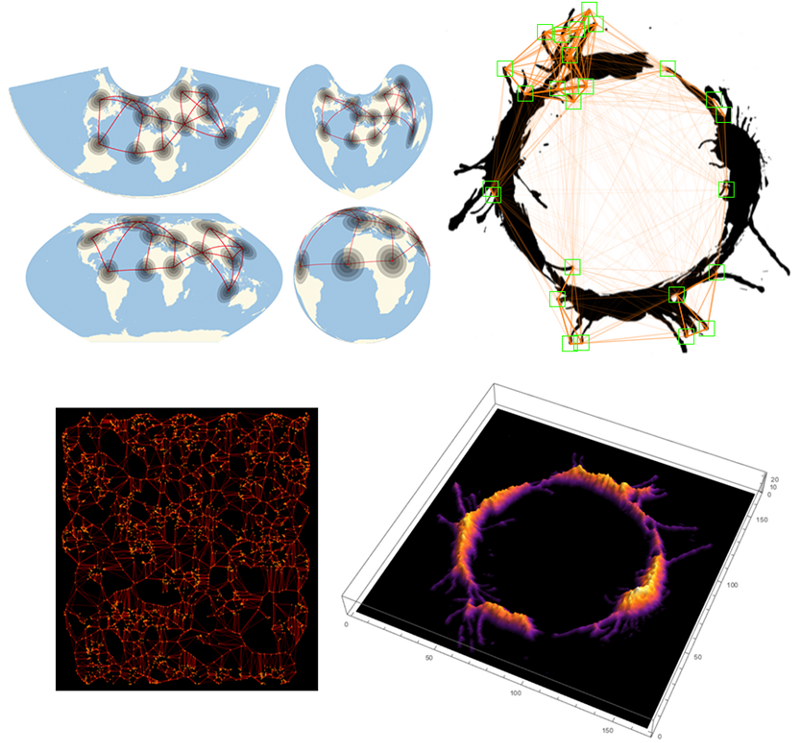
Kinoshiki gave Christopher raw data, as in real life, and he tried to analyze them. And turned each question into different versions of code and visualizations for Wolfram Language .
Christopher knew that often the program code from the films does not make sense (most of all, regardless of the context, filmmakers like the source code of nmap.c in Linux). But he wanted to make a meaningful code that really deals with the analysis of what is happening in the film.
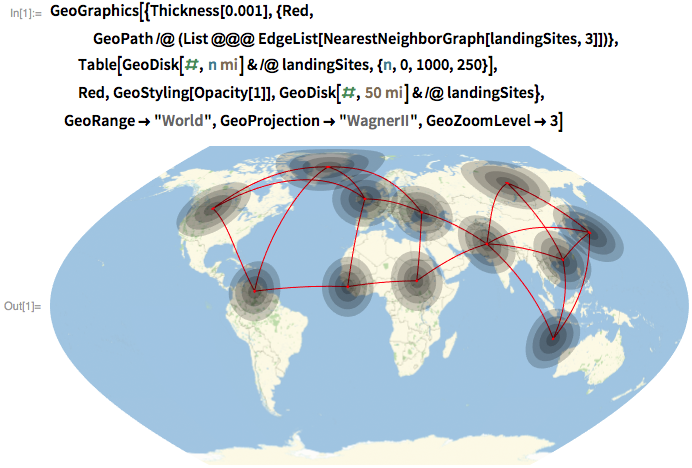
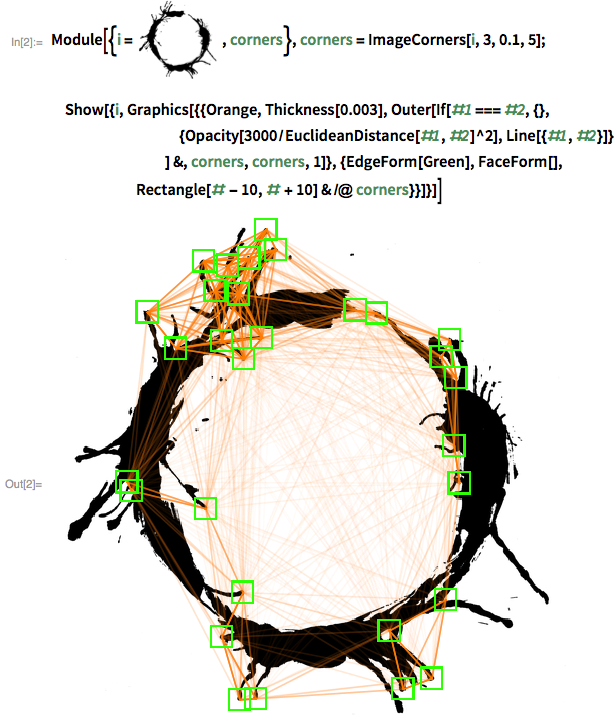
The final version of the film included a mixture of the code created by Christopher, some of its derivatives and separately added texts. Sometimes you can see the code. For example, there is an interesting frame with the analysis of writing of aliens, where you can see a rather elegant code on the Wolfram Language in the notebook of the Wolfram Language. And the specified code does exactly what is indicated in the address book. This is real code with real calculations.
Theory of Interstellar Travel
When I first saw the script, I quickly realized that in order to get coherent advice I needed to develop a coherent scientific theory of what was happening. Unfortunately, there was very little time - as a result, I, in fact, had one evening to invent a believable method of interstellar travel. Here is the beginning of the commentary I wrote for filmmakers that evening (I don’t quote it entirely so that there are no spoilers):
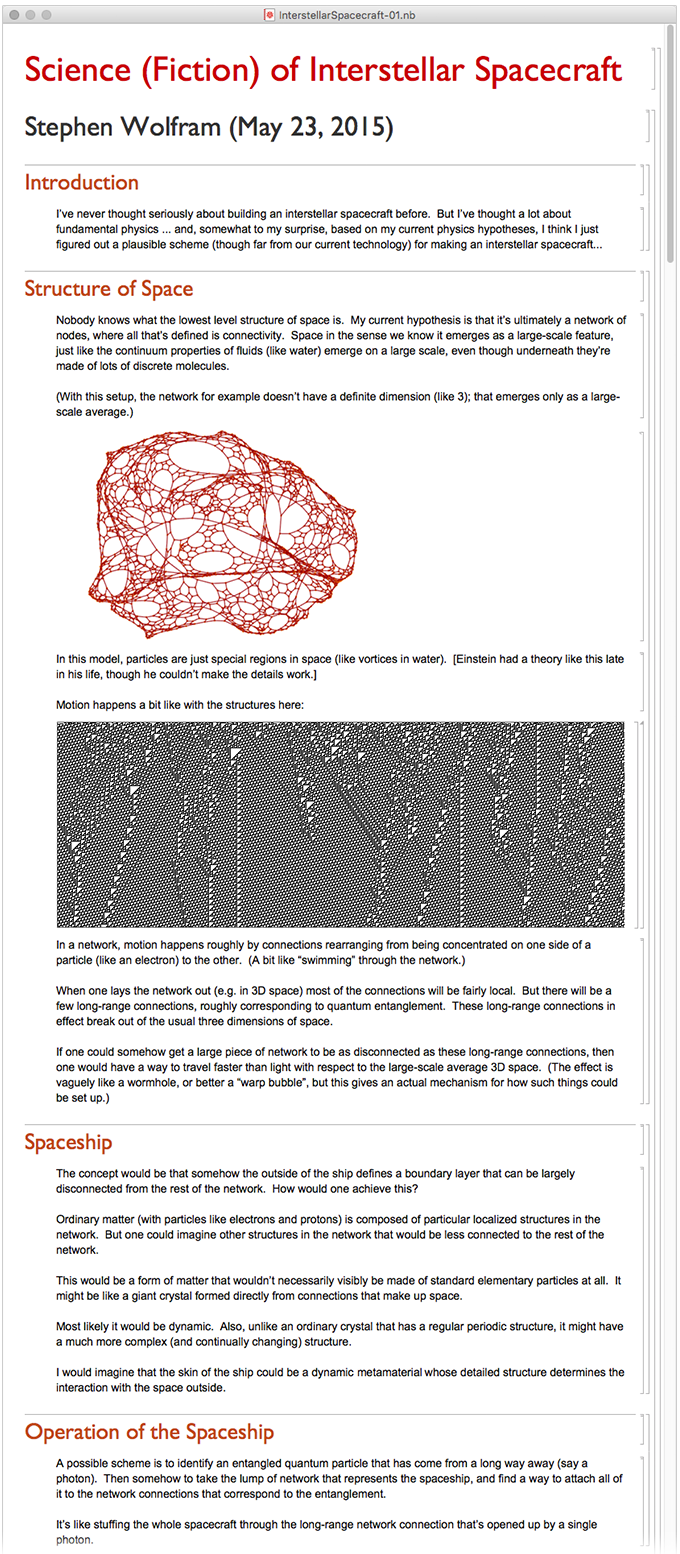
All these physical details in the film did not participate directly. But in order to give coherent advice on the scenario, it was useful to think over all of them. And they also led to different dialogues that sound quite sci-fi. Here are a few phrases that are not included (perhaps for the better) in the final version. "The whole ship moves in space like one giant quantum particle." "The aliens must be manipulating the whole network of space-time on a Planck scale ." "Space-time turbulence is created around the cover of the ship." “As if the ship's cover consists of atoms of an infinite number of types, and not only of 115 known to us” (this phrase should refer to a laser beam reflected from the ship's cover in the form of a rainbow). For such a “real scientist,” like me, it was very interesting to invent. I felt some kind of liberation. Especially due to the fact that one of these NF dialogues can lead us to a long and serious physical discussion.
Cinema required some definite theory of interstellar travel. And who knows, maybe in the distant future it will be true. But while we do not know. In general, some kind of “hack” of existing physics may appear, which will allow us to instantly make such trips possible. For example, in 1982 I worked on a theory that allowed us to constantly extract "zero point energy" from a vacuum. Over the years, this simple mechanism has become one of the most cited energy sources for interstellar travel, although I myself do not really believe in it.
Perhaps there is a more prosaic way to send a small spacecraft to at least those closest to the stars, allowing it to move using the pressure of laser light. Or you can tame black holes , create space-time curvatures, even agreeing with Einstein's theory of gravity. It is important to understand that even if we know the fundamental theory of physics , it may not be immediately clear to us whether it is possible to ensure movement faster than light in our Universe. Is it possible to somehow build quantum fields, black holes, and something else there? Computational irreducibility asserts that there is no upper limit to the complexity of such a system. As a result, you can use all the computational capabilities that are available during the life of the universe, do not invent the desired structure, and do not know for sure whether it is possible in principle.
Physicists - what are they?
Coming to the set, we will sooner or later meet Jeremy Renner. He sits on the steps of his trailer, smokes, and looks exactly like the brave heroes of many of his adventure films. I ponder how to describe as efficiently as possible what physicists are like. I come to the conclusion that you just need to start talking about physics. Therefore, I begin to explain theories related to the film. We argue about space, time, quantum mechanics, traveling faster than light, etc. I add a few stories, heard from Richard Feynman , about the work of the physicist "in the field" on the Manhattan project . The discussion turns out to be energetic, and I wonder if my manners and peculiarities are similar to those typical of physicists. I can not help but remember how Oliver Sachs told me how terribly it was for him to observe how many manners Robin Williams took from him for the film " Awakening " after a very brief conversation, and I wonder what Jeremy can learn from me in these few hours.
Jeremy seeks to understand how science is related to the plot of the film, and what aliens and people could feel. I'm trying to talk about how to understand the nature of things in science. Then I understand that it would be better to show it live by demonstrating the writing of the code for the Wolfram Language. It turns out that Jeremy himself needs to use the Wolfram Language in the film (as well as - I am very happy to say this - to the multitude of real physicists in life).
Christopher shows the code he wrote for the film, and how the controls for dynamics work. Then we talk about how the code is thought out. We do some tests. Then we write the code live. And our first example is based on the digits of pi, which we discussed in relation to the SETI project.
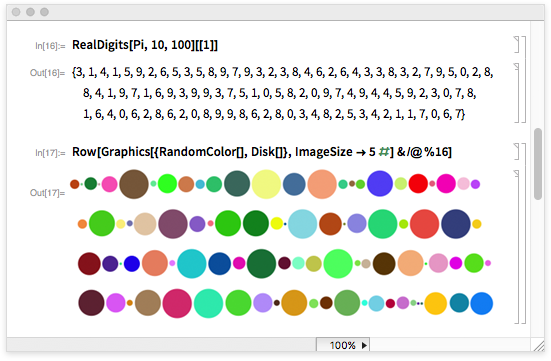
What to say to aliens
Part of the film is devoted to interstellar flights. But the topic of communication with aliens is more developed in him when they have already arrived. I thought a lot about the alien mind . But for the most part, not the way it is presented in the film - and in a more complicated case, when we do not have aliens or spacecraft, but there is only a certain stream of data, for example, a radio program, which is difficult to even understand whether it can be considered proof intelligence . Recall that often even the behavior of such a phenomenon as the weather, it seems to us difficult enough to produce the impression of consciousness.
But in the "Arrival" strangers are already here. And how to start communicating with them? We need something universal, independent of the details of human language or history. OK, if you meet strangers, you can point your finger at physical objects. Of course, this suggests that strangers have the concepts of individual objects instead of a certain continuum, but this can be put on, since they have managed to create spacecraft. But what if you need to be more abstract?
You can always turn to mathematics. But is it really universal? Do ship builders need to know about primes, integrals, Fourier series? Of course, in the development of human technology these things are obligatory. But are there other, perhaps better, technological ways of development? I think yes.
From my point of view, the most common abstraction related to how the Universe works is what we get when we consider the computational universe of possible programs. There is also math . And an endless variety of other abstract rule sets. And some time ago I realized that many of them make sense - and are well suited - for creating technology .
Therefore, looking at the computational universe of possible programs, what can you choose as intelligent universal things to start an abstract discussion with aliens?
Once we can point to individual objects, we can begin a conversation about numbers, first unarnally, then perhaps binary. Here is the beginning of the recordings I made for the film. Words and code - for people, and for others - just cards with graphics.

What comes after numbers and arithmetic? Interestingly, even what we have already discussed does not reflect the history of human mathematics. Despite the fundamental nature of binary numbers (appearing even in such old materials as I Ching ), they gained popularity recently - after the appearance of much more complex mathematical ideas.
So we do not need to follow the history of mathematics or science, or even the sequence in which they are taught. We need to find something that can be understood directly, without using words. What we would have learned, for example, by looking at an artifact extracted from the ground at an archaeological site.
It turns out that there is a class of computing systems that I have been studying for several decades, in my opinion, cellular automata are well suited for this role. They are based on simple rules that can be explained visually. They work by the repeated application of the rules, and often lead to the emergence of complex structures - and this, as we know, can be the basis of all sorts of interesting technologies.

Observing the cellular automaton, one can begin to build an idea about the whole world, or, “A New Type of Science, ” as I called the book about these things. But what if we need to convey more traditional ideas about science and mathematics? What should we do?
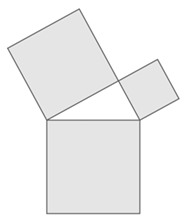
Maybe start with two-dimensional geometric shapes. In 1820, Gauss proposed to draw in the Siberian forest [ more precisely, plant trees in a special way in the tundra - approx. transl.] diagram representing the Pythagorean theorem to be seen by aliens.
But it's easy to get into trouble. You can show platonic bodies. Printouts of a 3D printer will do. But two-dimensional drawings with perspective depend on how the visual system is arranged. Networking is even more complicated - how do we know that these lines connecting the points represent abstract connections?
Maybe you can show the theorem of logic . But how to represent them? You need a symbolic representation - textual, with the help of trees, or something else. From computational examples, we know that logic does not serve as an ideal starting point for the presentation of general concepts. But in the 1950s it was unknown, and there is a charming book that tried to build a language to communicate with aliens based on logic.

What about concepts with numbers? In the movie " Contact ", primes became the key numbers. Despite their importance in the history of mathematics, they are not particularly needed in modern technology, and where they are used (crypto-protection), their appearance looks random.
In a radio signal, primes can serve as good proof of the presence of intelligence. But of course, they can be generated by programs - and fairly simple, including the same cellular automata . The sequence of primes does not automatically mean that it was created by an intelligent civilization. They could arise from some "natural" program.
Visually simple numbers are easy to show. But further work with them requires concepts that are not so easy to show directly.

It is very easy to fall into the trap of things that are obvious to a person. One of my favorite examples is Pioneer 10 , a human artifact that has advanced farther in space (almost 18 billion km , or 0.05% of the distance to Alpha Centauri). It has a plate on which is shown a 21 cm spectral line of hydrogen . Today, the most obvious way for such a representation would probably be a 21 cm long line. But in 1972, Karl Sagan and others decided to do something “more scientific” and made a schematic diagram of a quantum mechanical process leading to a spectral line. The problem is that the diagram is based on human conventions — for example, the use of arrows to designate quantum spins — which are not related to the concepts described and are very specific to the development of human science.
Let's return to "Arrival". To ask a question like "what is your goal on earth?", You need to go much further than binary sequences or cellular automata. This is a very interesting problem, which is strangely similar to the very important task today of communicating with AI and determining what their goals and objectives should be.
In a sense, now AI is a bit like alien intelligence. So far, we understand only human intelligence. Each example of its use contains details of human conditions and human history. But what is the intelligence that does not separate these details?
One of the conclusions of the science in which I was engaged is that there is no particularly clear line between intelligence and computational results. The same cellular automata or weather make things comparable in complexity to the brain. In a sense, they "think." But not like people. They do not have our context and our details.
But to communicate on topics such as goals and objectives, we need to find common points. In the case of AI, I work on what I myself call the " language of symbolic communication, " on a way to express concepts that are important to people, and transfer them to AI. To do this, there is an immediate practical application, like smart contracts. But there are long-term goals, such as creating an analogue of the constitution for the behavior of AI.
When communicating with strangers, we need to develop a common universal language that allows us to express important concepts for us. It is not easy. Natural languages are based on the details of human circumstances and history. My language of symbolic communication is trying to convey important things to people - and not something that can be important for others.
In the "Arrival" it is already known that strangers have something in common with us. As a monolith from "Space Odyssey 2001" we, judging by the form, establish that the alien spacecraft are artifacts. They do not look like strange meteorites. They look like something made with intent.
But with what? Intent cannot be defined abstractly. This can only be defined in relation to the historical and cultural platform. And in order to ask strangers about their goals and objectives, we first need to understand what cultural and historical platform we are on.
Sometimes I think about the day when we can develop the AI so much that we can ask him a question about their goals. I think we are disappointed. Because, in my opinion, there is no meaningful abstract definition of a goal. And the AI will not tell us anything unexpected. His definition of a goal will be a reflection of his story and context. And over this, as the creators of AI, we have serious control.
But with aliens it's not like that. But the film is about that too.
Filming
All my life I have been involved in big projects. And I always wondered how various big projects are organized. I am one of those people who watches film titles to the end. So it was interesting for me to look at a project to create a movie from close range.
In terms of scale, the filming of the movie “Arrival” is a project comparable to the release of the new full-fledged version of Wolfram Language. There are similarities and differences.
In both projects there are ideas and creativity. Both involve the sharing of many different skills. Both must put everything together to produce a coherent product.
In a sense, filmmakers are easier than programmers. They need to do only one thing that you can just look at.In the case of software, and especially with the development of languages, we need to do something that different people can use in an infinite number of different ways, including methods not provided for by us. Of course, you can always make new versions of the software, gradually improving it. The film can be made only once.
It is easier to work with software on personnel management than films such as “Arrival”. Well-managed software development has a constant rhythm, people have a permanent job and constant teams for a long time. For the filming of the film, a large number of people are usually attracted, many of whom might not have met each other before, for a short time. It's amazing that it works at all. I think that over the years many tasks in the film industry have been standardized, so that a person can work on something for a week or two, and then successfully transfer it to another.
I managed several releases of full-fledged software. And one would think that now any such issue would be a simple and relaxed process. But he is never like that. Perhaps because we are always trying to do new and innovative things. Or because this is the nature of projects. But I found that to bring the project to a good quality, I always need to strain very hard. At least in the case of our company, extremely talented people are always working on the project. But there are always unexpected tasks that take up a lot of energy, concentration and effort.
Sometimes it seemed to me that our process was a bit like filming a movie. In the early years of Mathematica, we even had captions that looked like movie films. Only categories of contributors were often invented by myself (“leading module developers”, “expression formatting”, “leading font developer”, ..). But after ten years because of the many patches it became too difficult to understand this, and the credits disappeared. And still, for some time I tried to organize parties in honor of the end of the work, just like filmmakers. But there were always some critical problems or improvements, and key developers could not come to the party, because they were fixed.
Software development — or, at least, language development — has some structural similarity to film shots. It all starts with the script - the overall specification of the final product. Then we try to create this. Inevitably in the end, looking at the result, we understand that we will have to change the specification. In films like "Arrival" this happens at the final stage (post-production). In software development, this is another development step.
It was interesting to see how the script and my proposals passed through the “Arrival” life cycle. It reminded me how I conduct software development: everything is gradually simplified. I make a detailed comment about correcting the dialogue. "You should not talk about avoiding imputation, your character is too analytically tuned." “You should not say that the spacecraft has passed a million light years. It will be out of the galaxy. Tell me a trillion miles better. ” Changes are being made. But then everything is simplified, and the basic idea is transmitted in some minimalist way. I did not see all the steps, but the results strongly reminded me of the development of software - to cut down all the difficulties and make everything clearer and simpler.
Can you fill the board?
My contribution to “Arrival” mainly occurred during the filming of the film in the early summer of 2015. Almost a year after that, I heard that the film is in the final stage. But all of a sudden in May I received an email: could I not fill the board with a plausible physics for the film?
In the film, there is a scene with Amy Adams in front of the blackboard, and it turned out that what was written on it related to high school physics — not what one would expect from the physicists of the level of the character Jeremy Renner.
I was surprised, because I realized that I did not have to work particularly hard on a whiteboard for markers. For all the work and presentations for 30 years I used computers, and before that, chalkboards and film projectors were used. But I honestly installed a marker board in my office and began to write on it (and I write very rarely by hand) what, in my opinion, a good physicist would have to write, trying to understand sudden interstellar travels.
That's what I came up with. Empty gaps are made to make it easier to embed Amy Adams moving in front of the board. For the final version of the film, the board was rewritten again, so in the film it differs from the photo below.

I imagined myself in the place of the character Jeremy Renner or his colleagues, who write down the standing ideas about the spacecraft and the corresponding formulas. After a while, I got a good story from physical facts and hypotheses.
Here she is.
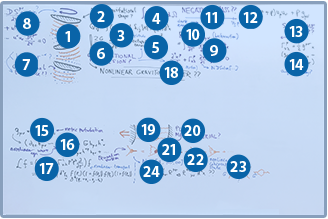
1. Perhaps the ship has such a strange shape, since it rotates while moving and creates gravitational waves .
2. It may be optimized to maximize the intensity of a certain pattern of gravitational radiation.
3. Einstein's formula for the force of gravitational radiation emitted by a mass with a variable distribution. Q ij is the quadrupole distribution moment calculated from the specified integral.
4. Higher-order elements, depending on higher-order multipole moments, calculated by the above spacecraft mass density ρ (Ω) integrals weighted by spherical harmonics .
5. Gravivola will lead to changes in the structure of space-time, represented by the 4-dimensional tensor h μν
6. Perhaps the ship somehow “floats” through space-time, powered by the effects of these gravitational waves.
7. It is possible that gravitational turbulence is created around the hull cover of the ship, with power correlations similar to those occurring around objects moving in a fluid (or the ship "boils" space-time around itself).
8. Papaptra equation for the evolution of the spin tensor in GR as a function of time τ.
9. The equation of geodesic motion, describing the movement of objects in a curved space-time. Γ is the Christoffel symbol , determined by the structure of space-time. And yes, these equations can be solved using NDSolve in the Wolfram Language.
10. Einstein's equation for the gravitational field generated by the moving mass (the field determines the movement of the mass, which itself affects the field).
11. Another idea - the negative mass of the spacecraft, or at least negative pressure. The pressure of the photon gas is 1/3 ρ; The most common version of dark energy has a pressure of -ρ.
12. The equation for the momentum energy tensor, which determines the combination of mass, pressure and velocity, is found in relativistic calculations for ideal fluids.
13. Perhaps the ship is a bubble with a different structure of space-time. The arrow points to the shape of the ship drawn earlier on the board.
14. Do the Christoffel symbols (“coupling coefficients on tangently spaced”) matter for the shape of the ship, according to calculations based on its spatial metric tensor ?
15. Gravivolna can be described as a perturbation of the space-time metric with respect to the flat background of the Minkowski space on which the STR operates.
16. The gravitational propagation equation, which takes into account the first few non-linear effects, due to which the wave affects itself.
17. Relativistic Boltzmann equation , describing the motion and collision in Bose-Einstein gas of such particles as gravitons .
18. An abstract idea: it is probably possible to create a “laser” of gravitons instead of photons , and the ship works on this principle.
19. Lasers are a quantum phenomenon. This is the Feynman diagram of the interaction of gravitons in the cavity (photons do not have such direct nonlinear interactions with each other).
20. How to make a mirror for gravitons? Perhaps this is a metamaterial with a special microscopic structure down to the Planck scale.
21. In lasers, coherent states are used from superpositions of an infinite set of photons, which are formed by infinitely imbedded production operators applied to the theoretical vacuum of a quantum field.
22. For this, there is a Feynman diagram: this is the self-consistent Bethe – Salpeter equation for a bound graviton, which can be related to a graviton laser.
23. The main nonlinear interactions of gravitons in the perturbed approximation of quantum gravity.
24. A possible qualifying term for the Einstein-Gilbert action from GR for quantum effects.
I understand that these explanations themselves may seem an alien language! But they are also quite modest compared to the language of "full-fledged physics". Let me explain the physical history from the board more simply.
It begins with the obvious properties of the ship: it has an unusual asymmetric shape. It looks like a Celtic stone , which can begin to rotate in one direction, and then change direction. And I thought: maybe the ship is spinning. And any massive non-spherical rotating object will create gravitational waves. Usually they are too weak to detect, but if the object is massive enough or the rotation speed is large enough, the waves can also be strong. Indeed, last year, after a 30-year search, gravitational waves from two black holes rotating around each other and merging were discovered - and they were found at a distance of a third of the observed Universe. Accelerating masses create gravitational waves in the same way as accelerated electric charges create electromagnetic.
Imagine that a ship rotates so quickly that it creates a lot of gravitational waves. And what if we could lock these waves in a limited space, using the movement of the ship itself? Then we would get the interference. And what if they are coherently amplified, as in a laser? Then they will become stronger and begin to influence the movement of the ship - perhaps pushing it through space-time.
But why will the waves intensify? In a conventional laser using photons (particles of light), it is necessary to constantly create new photons, pumping energy into the material. The photons are Bose-Einstein particles (bosons), so they tend to "behave the same way" - so the laser light is a coherent wave. Electrons are fermions, which means they try not to do the same thing, which leads to the principle of prohibition , which is critical for the stability of matter.
You can imagine that light waves are made up of photons; and gravitational waves may consist of gravitons (although we do not yet have a full-fledged theory for them). The photons do not interact with themselves - to put it simply, since the photons react with such particles as electrons having an electric charge, while the photons have no charge. Gravitons, on the other hand, interact with each other, because they interact with everything that has energy, and they themselves possess it.
Such non-linear interactions can lead to unusual effects. For example, gluons in quantum chromodynamics interact nonlinearly in such a way that they remain imprisoned inside such particles as protons, as if “glued” together. It is not entirely clear where nonlinear graviton interactions will lead to. Perhaps to a self-sustaining "graviton laser."
The formulas above describe the creation and effect of gravity waves. The lower ones refer to gravitons and their interactions. The upper ones refer to GR. The lower ones are a mixture of classical and quantum approaches to gravitons and their interactions. Diagrams are Feynman diagrams, schematically showing the propagation of gravitons through space-time.
I do not know whether a graviton laser is actually possible, and how it would work. But in a conventional photon laser, photons, in fact, jump inside some kind of cavity, whose walls work like mirrors. Unfortunately, we do not know how to make a mirror for gravitons - just as we do not know how to close from the gravitational field (such a shield would be dark matter, if it really exists). On the blackboard, I pointed out guesses about the possibility of producing a Planck scale metamaterial of 10 -34 meters (where quantum effects become important for gravity), which could work as a mirror for gravitons. Another possibility is the operation of a graviton laser based on the principle of a free-electron laser without cavities.
Remember, I wanted to write on the blackboard that a good physicist, pulled out of the state laboratory, might have thought, faced with the situation of the film. These are more “common” things compared to what I personally invented for interstellar travel. But this is because my theory depends on my other ideas about the work of fundamental physics, which have not yet become generally accepted in physical society.
What is the correct theory for interstellar travel? I dont know. I would be very surprised if the main theory invented by me for the film, or the theory on the board would be correct. But who knows? Of course, it would be very helpful if aliens arrived in space ships to show us that interstellar flights are possible.
What is your purpose on earth?
If aliens appear on Earth, one of the obvious questions will be: why are you here? What is your goal? This movie characters talk a lot. And when Christopher and I were on set, we were asked to make a list of possible answers that could be placed on the board or on the tablet. Here is what we came up with:
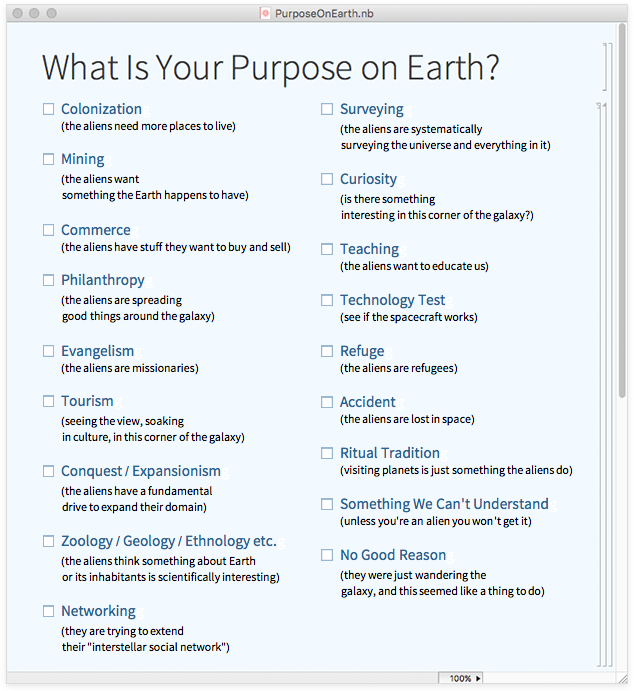
• Colonization.
• Mining.
• Trade.
• Philanthropy.
• Evangelism.
• Tourism.
• Conquest and expansion.
• Zoology, ethnology, geology.
• Expansion of the interstellar communications network.
• Mapping the universe.
• Curiosity.
• Training.
• Test technology.
• Search for shelter.
• Accident.
• Ritual tradition.
• Something incomprehensible to people.
• Just.
I have already noted that the goal principle itself is something that is closely related to cultural and other contexts. Interestingly, in drawing up such a list at different historical moments, people would place different items in it. It’s also interesting what AI goals and people can pursue in the future. I may be too pessimistic, but it seems to me that future people, AI and aliens will have the answer to this question in the computational universe of possibilities - for which we do not have words and concepts today.
And here it is a movie
The movie turned out quite good, the early reviews are encouraging. It is very interesting to see such things in it (and Christopher’s code):
It was interesting to participate in its creation, it stimulated. I began to understand better what includes the creation of all those films that I watch - and what it is worth to combine science with a fascinating fiction. I also started asking scientific questions that I hadn’t reached before - connected with all those things that interest me.
I can't help but think about what would happen if the aliens actually arrived on Earth. I want to think that having participated in the creation of the "Arrival" I am a little more ready for this. And of course, if their ships resemble giant Celtic stones, we already have a good code for the Wolfram Language for this.
Source: https://habr.com/ru/post/399389/
All Articles